25 Sep 2020 - {{hitsCtrl.values.hits}}
Who will stop building impending disasters?
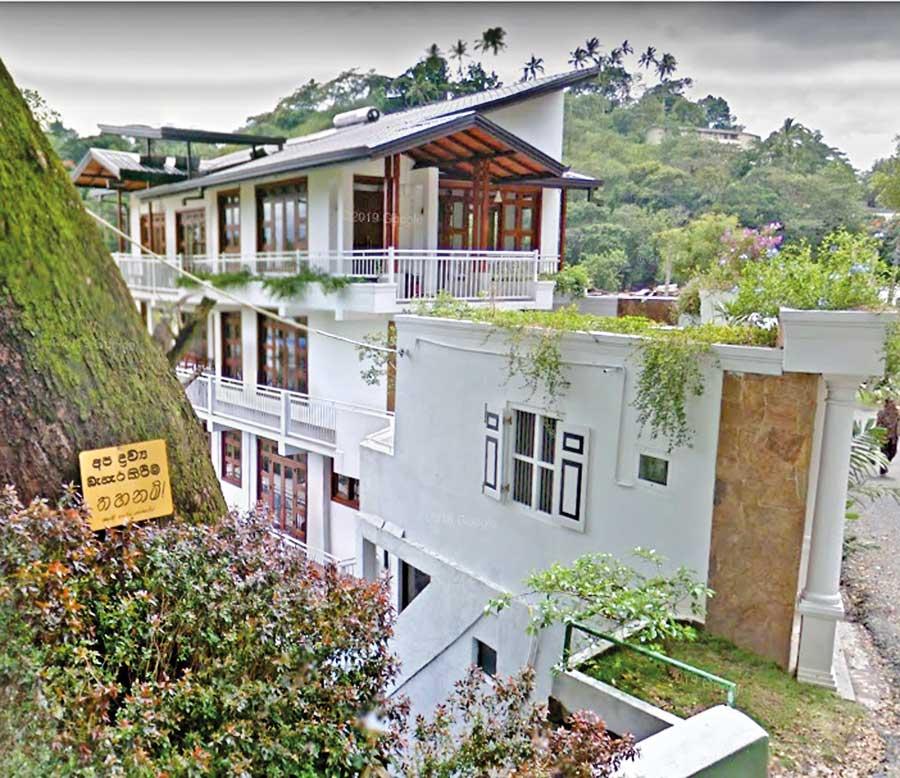
Before
Tragedy struck when a five-storey building caved in and collapsed, killing a young family of three in Kandy last week. The construction in the steep slopes of Sanghamitta Mawatha, Buwelikada collapsed during the early hours of Sunday. 
According to the police, residents had managed to evacuate the collapsing building. The debris which fell upon a hotel killed three. Following a dramatic search and operation mission led by the military, a public debate ensued; who is responsible for this tragedy?
Unfortunately, the general public often have limited knowledge about the hidden structural defects, usage limitations and regulatory compliance requirements that should be fulfilled during the construction phase and also during the lifespan of the building. This knowledge is important to ensure consumer health and safety, to obtain a fair return on investment and to facilitate building functionality, sustainability and comfort.
The Daily Mirror met with National Building Research Organisation (NBRO) District Officer Samantha Bogahapitiya who is among a number of professionals of government authorities investigating this incident. We asked him what he believed was the cause of this collapse.
“According to available data, this area is a valley, where two slopes meet. The centre or the place where this building was constructed had a considerable slope on the side. It was also observed that the location was also a catchment area where water flows. It was upon this kind of land that this building was constructed,” he said. Bogahapitiya said that at present the NBRO officers only possessed the initial information available in the aftermath of the collapse. He said that coupled with the experience and expertise of the officers, they were certain the environmental conditions of this site was unfavourable for a building of such a nature.
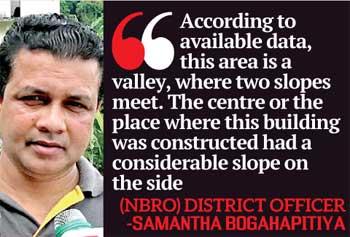 “Valleys such as these are known to have weak soil, as they have weakened and withered. The digestion of soil is rapid and the outer layers are rather weak. Given such circumstances how can a five-storey building last long? I’m not sure how it lasted this long as the environment, water flow and other activities can all affect such a structure,” he explained.
“Valleys such as these are known to have weak soil, as they have weakened and withered. The digestion of soil is rapid and the outer layers are rather weak. Given such circumstances how can a five-storey building last long? I’m not sure how it lasted this long as the environment, water flow and other activities can all affect such a structure,” he explained.
Asked as to how the approvals for this particular building were granted if the circumstances were such, Bogahapitiya said that the NBRO’s authority in this regard has been limited. A circular was issued in 2011 after a similar building collapse in Primrose, Kandy. Although there were no fatalities reported in this incident, several landslides reported in the central hills caused several deaths at the time. According to the circular it is mandatory to seek the approval of the NBRO prior to any construction.
Bogahapitiya believes that there are numerous other unstable buildings and places in the city. The officials have also received a number of complaints stating that several places across Kandy are vulnerable and prone to similar hazards.
“Many Constructions in Kandy are built on slopes and hilly areas. These buildings may be built either with or without the necessary permits. However their stability, especially the structural stability are currently being investigated.”
“It is imperative that constructions are monitored because this is not the first time a building has collapsed this way. It is a social need at this point. Nevertheless it must be said that it is no easy task. These activities require resources and funds. There are many areas to be considered.
But examining and monitoring process must be initiated promptly with whatever resources available,” he said adding that measures are underway to carry out such investigations.
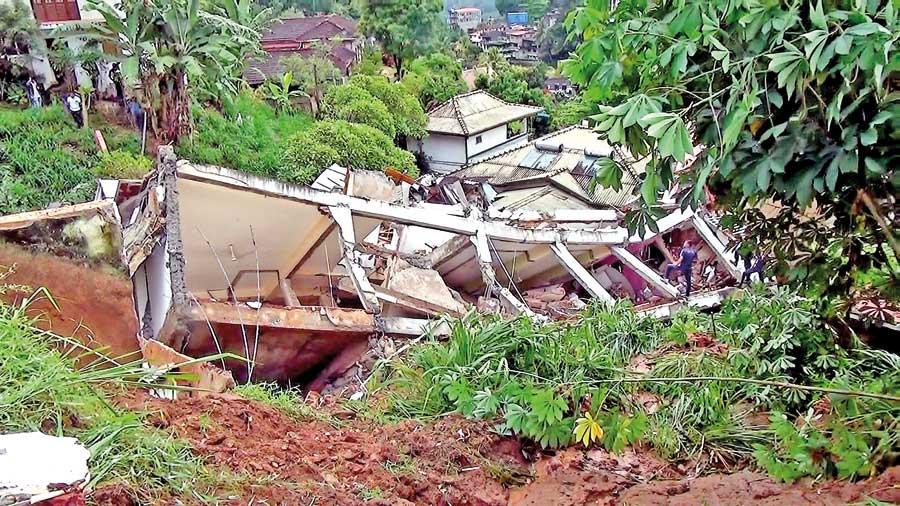
After
Over 50 complaints this week
“We receive many complaints from time to time. For instance a person who is concerned of a certain construction in their area may come forward with their grievances. Cracks and warps in columns or beams may be observed, this is very common. But the number of complaints we have received lately has risen due to this incident,” Bogahapitiya said.
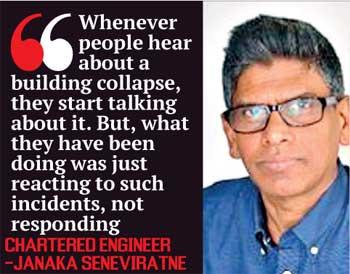 “We now hope to carry out initial investigations into these complaints and deliberate on further action. With the present situation we have received over 50 complaints this week. We expect this number to rise in future, as people are more aware and alert of this issue now. Regardless of the number however, we use these complaints to consider on the locations that we would investigate and research in future,” he stated.
“We now hope to carry out initial investigations into these complaints and deliberate on further action. With the present situation we have received over 50 complaints this week. We expect this number to rise in future, as people are more aware and alert of this issue now. Regardless of the number however, we use these complaints to consider on the locations that we would investigate and research in future,” he stated.
Asked about the complex nature of the approval process, Bogahapitiya said that there are two sides to this issue. “People have expressed their own concern as well as on other people’s properties. When a complaint is made we examine initially if the approvals are in place. We then examine if the constructions are according to the approved plan.” 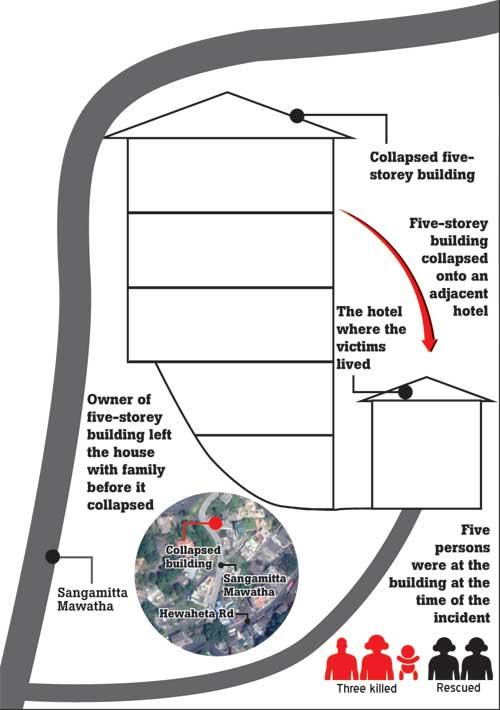
“When an officer approaches us with construction plans to be approved, we attempt to deliver the permits adhering to the rules and regulations as fast as we can. While the party seeking these approvals are keen on getting their approvals as soon as possible, it is also their responsibility to ensure that they help us.”
Approvals too also diverse, he explained further. “In some cases an approval only means that a certain authority has no objection towards a particular development. The NBRO’s approvals however are different as it involves scientific research. For instance, geology, hydrology as well as land use are all examined during one of the initial inspections undertaken by the NBRO. If these matters are also in order we then proceed to grant approval. There is no deliberate delay in granting these approvals on our part.”
Meanwhile he said that in some cases a final decision cannot be reached with the initial data available. “It’s similar to getting treatment from a physician who might prescribe various tests such as x-rays and scans to determine the root cause of illness. It is the responsibility of the sick person to help the physician in this case. Similarly, it is also the responsibility of whoever is undertaking construction to ensure that they help us with all the required details. Sometimes despite the availability of all this data, the results may be inconclusive and require further tests for which we may not have funds or resources.”
Bogahapitiya stressed that construction therefore is a responsibility of both the authorities and the builders. “People are focused on the external appearance of the construction rather the structural stability of the buildings. In the end whatever people construct is according to their whims and not according to our recommendations,” he opined.
“We are currently gathering information on buildings which have to be examined and monitored. I believe more than 90 per cent of these constructions have deviated from the original approved plan. The reality is that the number of constructions which have adhered to the regulations are minimal. Therefore it is not the officials who are to be blamed but those who undertake these constructions,” he stressed.
The Planning and Building regulations contain several building specifications with regard to minimum extent of land, maximum number of floors, minimum road width, minimum width of plots and plot coverage ratio, etc. Issuance of preliminary clearance, approval of plans for constructions are done by the UDA while the constructions below the said specifications are handled by the Municipality.
In an interview with the Daily Mirror, Janaka Seneviratne, a Chartered Professional Engineer and an International Professional Engineer of the Institution of Engineers, Sri Lanka and Australia said unfortunately Sri Lankans wake up only after an incident.
“Whenever people hear about a building collapse, they start talking about it. But, what they have been doing was just reacting to such incidents, not responding. The government should understand that the real problem lies somewhere else.”
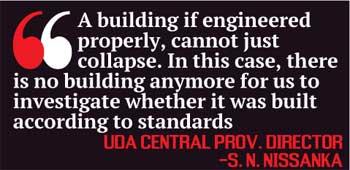 What is the Job of Professionals?
What is the Job of Professionals?
“When a building plan is being done, first the architect comes for the architectural design. Then, the engineers should take over the task. Geo-technical engineers should investigate the land the soil condition. That is when they recommend about what kind of a foundation is required for the construction project. The next job is for the structural engineers to focus on the foundation and other structural elements of the building. Then, the services engineers play their role in service engineering including air conditioning, ventilation system, fire services, sewerage system, water supply system and etc. Depending on the location of the land, environmental impact should also be assessed. The noise that could be generated from the construction project should also be assessed.
Meanwhile, the role played by traffic engineers should not be forgotten as they investigate what kind of a new traffic will be generated due to the new building and how it will impact the locality. As I said above, there are so many aspects that should be checked before and even after constructing a building. Are we following the above steps? I don’t think we are. If we were, unfortunate collapses like the Kandy incident would not have happened.
The job of the professionals does not end with the completion of a building. There are very important matters that need to be checked after the completion of the construction. Constant checkups and reviews such as condition assessments at least in every five years are mandatory in maintaining buildings. That is how we can find out about which areas of the building need repair and renovations in order to make them safe and lasting.” 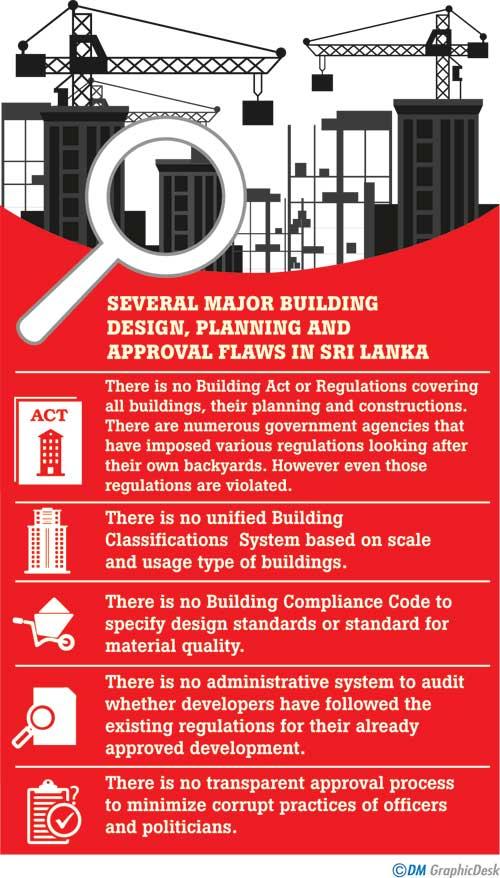
Who is to blame?
Seneviratne was certain about who to blame for building collapses.
“I don’t blame politicians. I don’t even want to blame the building owners and the people who are doing such wrongful constructions. I blame the professionals in Sri Lanka who have failed to do their job properly. If the professionals did their job right, then we would be able to point fingers at those who have violated the regulations.”
Several state authorities and professional bodies have now come together to come up with a programme to review existing constructions in the Kandy city. These include the Kandy Municipal Council, Urban Development Authority (UDA), the Central Province Engineering Department as well as the Peradeniya University. UDA Central Province Director S. N. Nissanka said that the project would be first implemented within the Kandy city limits, with the expectation of extending it to the fragile areas of the central province.
However Nissanka too agrees that the responsibility lies with professionals who undertake or endorse construction projects.
“I believe that the responsibility of a construction falls on three parties. Firstly, as officials, we have a responsibility to review if the project is carried out under the guidance and approval of professionals. It is then that we grant approval. Secondly the responsibility falls on professionals, to ensure that the construction is carried out as according to the plan, prior to the issuance of certifications of compliance,” he said.
“The proprietor is then responsible —regardless of who inhabits the building— to ensure that the construction is carried out through qualified professionals. It is not just a building but an investment for the country. Therefore, the quality of the construction must be ensured by the applicant and the builder. A building if engineered properly, cannot just collapse. In this case, there is no building anymore for us to investigate whether it was built according to standards,” Nissanka stated.
The Lack of a National Building Code
The Chartered Professional Engineer Janaka Seneviratne believes that Sri Lanka has the worst possible regulatory and compliance mechanisms.
“Sri Lanka does not have a consolidated buildings act and building regulations. We don’t have a national building code. We also don’t have a sound development administrative system, building application and approval system. We don’t maintain records of existing buildings properly. We don’t have a building conditions
auditing system.
I am one of the professionals who advocated for having a national building code for Sri Lanka. But, the interest of those who have authority to do it is very poor. Their response and the support were in a sorry state. As far as I am concerned, Sri Lankan authorities are trying to adapt an international building code for Sri Lanka and I don’t approve of it. The local construction practices and the local environmental conditions are completely different. A national code for Sri Lanka has to be our own, which should be designed and prepared by locals. Introducing an international building code is not going to work for Sri Lanka. Another important point is the national building code has to be made a legal document. Otherwise, those who violate the code would not be legally obligated to be answerable and accountable. If Sri Lanka does not take these important actions without further delay, we will lose more innocent lives in future.”

01 Jan 2025 19 minute ago
01 Jan 2025 47 minute ago
01 Jan 2025 2 hours ago
01 Jan 2025 5 hours ago
01 Jan 2025 5 hours ago